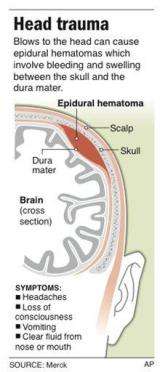Brain injury victims can seem OK, symptoms delayed

(AP) -- At first, Natasha Richardson said she felt fine after she took a spill on a Canadian ski slope. But that's not unusual for people who suffer traumatic head injuries like the one that killed the actress.
Doctors say sometimes patients with brain injuries have what's called a "lucid interval" where they act fine for an hour or more as the brain slowly, silently swells or bleeds. Later, back at her hotel, Richardson fell ill, complained of a headache, and was taken to a hospital. She died Wednesday in New York.
An autopsy Thursday showed that the 45-year-old actress hit her head, which caused bleeding between the skull and the brain's covering, resulting in what's called an epidural hematoma. It's a type of injury often caused by a skull fracture.
Because of that lucid interval, doctors always tell patients who seem OK after a brain injury to have someone keep a close eye on them, in case symptoms emerge.
Symptoms - headache; loss of consciousness; vomiting; problems seeing, speaking or moving; confusion; drainage of a clear fluid from the nose or mouth - appear after enough pressure builds in the skull. By then it's an emergency.
"Once you have more swelling, it causes more trauma which causes more swelling," said Dr. Edward Aulisi, neurosurgery chief at Washington Hospital Center in the nation's capital. "It's a vicious cycle because everything's inside a closed space."
Pressure can force the brain downward to press on the brain stem that controls breathing and other vital functions, causing coma or death. Frequently, surgeons cut off a portion of the skull to give the brain room to swell. Or they drain the blood and remove clots that formed.
"This is a very treatable condition if you're aware of what the problem is and the patient is quickly transferred to a hospital," said Dr. Keith Siller of New York University Langone Medical Center. "But there is very little time to correct this."
Details of Richardson's treatment have not been disclosed.
A CT scan can detect bleeding, bruising or the beginning of swelling after an injury. The challenge is for patients to know whether to seek one.
"If there's any question in your mind whatsoever, you get a head CT," Aulisi advised. "It's the best 20 seconds you ever spent in your life."
©2009 The Associated Press. All rights reserved. This material may not be published, broadcast, rewritten or redistributed.













